Mistletoe Loranthaceae
Guest Author: Kat Morgenstern
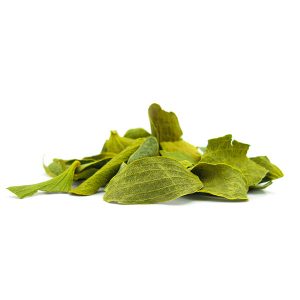
Botanical Name: Viscum album
Synonyms: Bird Lime, Birdlime Mistletoe, Mystyldene, Lignum Crucis, All-heal
German Names: Affolter, Donnerbesen, Heil aller Schäden, Hexenbesen, Nistel, Vogelleimholz, Heiligholz, Heilkreuzholz, Drudenfuss, Wintergrün, French: Herbe de la Croix, Gui de Chêne
Parts of the Plant that are Used
Leaves and stems.
Harvest
Autumn, before the berries form.
Constituents
The chemical constituents of Viscum album may differ depending on the host plant. Typically, the plant contains viscotoxin, triterpenoid saponins,
Plant Description
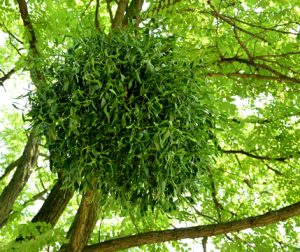 Mistletoe grows as a parasite on various deciduous trees. Occasionally it also grows on pines. Contrary to popular belief it is rarely found on oak trees but commonly associated with apple, poplar, and lime. Mistletoe has some relatives that actually grow as trees or bushes, which suggests that the parasitic habit is acquired and has subsequently been passed on genetically.
Mistletoe grows as a parasite on various deciduous trees. Occasionally it also grows on pines. Contrary to popular belief it is rarely found on oak trees but commonly associated with apple, poplar, and lime. Mistletoe has some relatives that actually grow as trees or bushes, which suggests that the parasitic habit is acquired and has subsequently been passed on genetically.
Mistletoe has an odd appearance: a yellowish ball hanging high up in the tree, visible only after the host tree has lost all its leaves. Mistletoe is evergreen and sustains its
Ecology
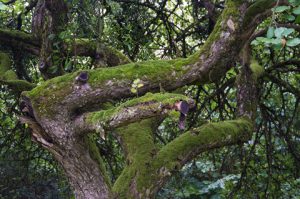 Although mistletoe is a parasite and as such dependent on the host-plant for nutrients and water, its does not rely on it for carbon dioxide. Since mistletoe produces green, chlorophyll-containing leaves, it can perform its own photosynthesis. As a rule mistletoe does not kill the host-plant and thus is not really harmful to it. While birds feed on the berries without apparent harm, they are toxic to humans.
Although mistletoe is a parasite and as such dependent on the host-plant for nutrients and water, its does not rely on it for carbon dioxide. Since mistletoe produces green, chlorophyll-containing leaves, it can perform its own photosynthesis. As a rule mistletoe does not kill the host-plant and thus is not really harmful to it. While birds feed on the berries without apparent harm, they are toxic to humans.History, Mythology and Folklore
The enigma of the mistletoe, airborne between heaven and earth, has always been a mystery. Where did it come from? How could it sustain itself, without roots, yet bear leaves and fruit, even throughout the winter long after the green life-force has retreated into the womb of the earth?
The Druids revered the Mistletoe as the holiest of holies, especially when it appeared on an Oak, their most sacred tree. It was their ‘Golden Bough’, the key to the heavens and the underworld. The mysterious plant was regarded as the reproductive organs of Thor, the god of thunder, who also presided over the sacred oak tree. In the Druidic tree calendar, the 23rd of December is given to the mistletoe, the day when it was ceremoniously cut. After offering prayers the chief Druid would ascend into the tree to cut the mistletoe with a golden sickle. Utmost care was taken to prevent the herb from touching the ground. Instead, it had to be caught in a white cloth. Two white bulls, sacred to the Moon-Goddess, all dressed up in garlands were also sacrificed on the holy occasion. The sacrifice of the regenerative power of the solar deity was to bestow blessings of abundance and protection from all evil for the new year. It represented a marriage of the solar and lunar forces, a harmonization of all opposites in perfect balance at the turning point of the year. To celebrate the return of the life-force an orgiastic celebration ensued.
Tame and shallow remnants of these ancient and long forgotten ritual enactments have survived even into the 21st century. To this day
Mistletoe was believed to ward off all evil, bad spirits and witchcraft, and was sometimes worn as a protective amulet. It was also believed to bestow fertility and abundance.
In Norse mythology, a darker, though
This legend follows the classic pattern of the solar hero myth, promising redemption and renewal after a period of darkness—a perfectly appropriate myth for the celebration of the winter solstice, which marks the return of the Sun God.
Hardly surprising, the mistletoe also found its way into Christian mythology as the wood from which Christ’s cross was said to have been fashioned. It is due to this disgrace that the mistletoe has been reduced to a parasitic existence.
In Greek mythology mistletoe was also associated with the Underworld. Here, the sacred bough presented the key with which a living mortal could enter the Underworld and return to the world of the living unharmed, as is told in the story of Aeneas.
Aeneas, a young hero, enters the underworld by the power of the golden bough and the aid of the age-old Sybil as his guide. He enters this frightful place in search of his father to seek his guidance and advice. He finds him and receives his teachings concerning the cycles of life and death, which he had come for. Eventually he returns safely to the world of the living. But it is the mistletoe that provides him with the key to his destiny and opens the gates to the transformational powers of the underworld from which he returns spiritually reborn.
Magical Powers
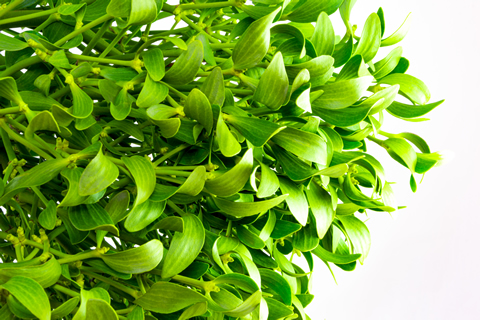
Protection, key to life’s mysteries, fertility, abundance, blessings, peace, harmony, balance of opposites, love, transformation. Astrologically this herb is governed by the Sun and Jupiter.
Medicinal Uses
Actions:
Indications: stress, nervous conditions, heart problems, epilepsy
Internal Use
“In former times amulets made from mistletoe wood were thought effective in warding off epileptic attacks.
Mistletoe not only has an interesting
Mistletoe is also known as a cardioactive agent that improves the pulse, regulates the heart rate and simultaneously dilates the blood vessels, thus lowering blood pressure. It reduces headaches and dizziness caused by high blood pressure. However, from the available literature, it is not entirely clear in which form mistletoe should be administered for this effect. Some sources maintain that the cardioactive principle is only effective if applied by injection while other sources recommend standard teas, tinctures, and extracts. One source also states that the active principles would be destroyed by heat and thus should only be prepared by cold infusion. The differing opinions regarding the preparation methods are certainly confusing. Recently another interesting property of mistletoe has become a matter of scientific interest. Since ancient times mistletoe has been used to treat tumors.
Culpeper states:
“The Birdlime doth mollifie hard Knots, Tumors, and Impostumes, ripeneth and discusseth them; and draweth forth thick as well as thin Humors from the remote places of the Body, digesting and separating them
This property has been subject to research and it has been found that mistletoe preparations show cytotoxic properties in vitro and to some degree in vivo. It has also shown to stimulate the immune system response through an increased number of white blood cells. Both of these properties have made mistletoe a candidate for cancer and AIDS research. Indeed, a mistletoe preparation is used in chemotherapy. Studies show both equal and better survival rates of patients treated with certain mistletoe preparations. However, the interviewed patients reported a better quality of life, as mistletoe does not produce the nausea and hair loss associated with other cytotoxic chemotherapy agents. Also, the immune response is improved. A negative side effect of subcutaneous treatment is the possibility of local infection at the site of injection. For detailed study results check out:
HerbMed
National Cancer Institute
Mistletoe is also reputed to regulate digestive functions, curing chronic constipation, probably through its stimulating effect on the gall bladder. It also increases metabolic activity generally and is thus recommended as a blood cleanser.
Older sources also recommend it in cases of sterility and menstrual difficulties. With regard to the aforementioned nervine
External Use
Externally mistletoe use is no longer common, but according to old sources it can be prepared as a plaster (mixed with wax to make an ointment) and applied to hardened swellings and tumors. It can be usefully employed in crèmes to soothe sensitive, sore skin. Such crèmes are disinfecting and soothing and reduce abnormal cell production, which could be useful in psoriasis lotions and anti-dandruff shampoos.
Caution
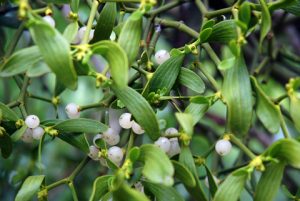
Copyrighted by Kat Morgenstern 2002
Visit Sacred Earth to read more articles by Kat Morgenstern, to subscribe to her ezine newsletter, and to plan your next eco-vacation.
References
National Cancer Institute
Image Credits
Mistletoe Hanging from Tree
Dreamstime ID 55694117
© Renata Routova
Dry Mistletoe Leaves
Dreamstime ID 10662581
© Uros Petrovic
Tree Covered with Moss & Mistletoe
Dreamstime ID 103673697
© Andreas Boxleitner
Dreamstime ID 48254695
© Karayuschij
Green Mistletoe Leaf
Dreamstime ID 105276002
© Dmytro Yashchuk
Mistletoe Berries
Dreamstime ID 93424793
© Vnikitenko
Many experts throughout history have regarded cancer salves and pastes as the most thorough, safe, and efficacious way to treat cancer, especially skin and breast cancers but also cancers of other organs. In this book, Ingrid Naiman meticulously traces the use of such products in ancient India and by Hildegard of Bingen, Native Americans, and modern physicians. She provides detailed instructions for making and using the salves, a fair comparison of the pros and cons, and eight pages of color pictures showing responses to the products. Visit her Cancer Salves site for more information, answers to frequently asked questions, and a checklist for people facing cancer.

Cancer Plants
Donations
Your donations are greatly appreciated.
Information
Newsletter
To be notified of new posts to this site, please subscribe, using the link button below. You can cancel your subscription at any time you choose.
Copyright by Dr. Ingrid Naiman 2003 and 2018
All Rights Reserved || Institute for Invisible Epidemics
